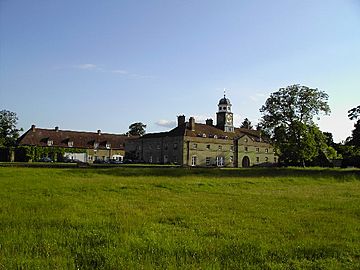Wandlebury Hill facts for kids
Quick facts for kids Wandlebury Hill |
|
|---|---|

The stable block at Wandlebury House
|
|
| Highest point | |
| Elevation | 74 m (243 ft) |
| Prominence | 10 m (33 ft) |
| Parent peak | Great Wood Hill |
| Geography | |
| Location | Gog Magog Hills, England |
| OS grid | TL493533 |
| Topo map | OS Landranger 154 |
Wandlebury Hill is a small hill located in the Gog Magog Hills. These are a group of low chalk hills found southeast of Cambridge, England. The hill is 74 meters (about 243 feet) high. This is the same height as a nearby hill called Little Trees Hill.
The top of Wandlebury Hill is part of Wandlebury Country Park. This park is a nature reserve looked after by Cambridge Past Present and Future. Long ago, people lived here in the Bronze Age. About 2,500 years ago, during the Iron Age, there was a hill fort here. It was known as Wandlebury Ring. This fort had deep ditches and earth walls. Wooden fences called palisades helped keep them strong. Even though the fort is gone, you can still see the ditch. It's called the Ring and is about 5 meters (16 feet) deep in some places. You can even walk along its edge! There is no proof that this fort was ever used for fighting.
The park has many beech woodlands and open fields. It is a great place for birdwatching. There is a special bird hide, or shelter, called Banyard bird hide. It looks out over Varley's Field. You can visit the top of the hill when there are no sheep or Highland cattle in the field. If you bring a dog, it must be on a lead in the park. You can reach the hill by walking from post 3 of the nature trail. It's an easy walk through the woods with almost no climbing.
Contents
Wandlebury House and History
A large building called Wandlebury House once stood inside the Ring. Many important people lived there, including Francis Godolphin, 2nd Earl of Godolphin. The house is no longer there, but its big stable block still stands. This building is now used for offices and places to stay.
Under an archway in the stable block, you can see the grave of a famous horse. This was the Godolphin Barb horse, which died in 1753. You can find maps and leaflets about the park in the porch of the stable block.
A piece of history from World War II was also once found here. The tail of a crashed Wellington Bomber plane was stuck high in a beech tree. It stayed there until strong winds blew it down in the early 1990s.
Mysteries of Wandlebury Hill
People have wondered about the "Wandlebury Enigma" for a long time. This refers to ideas about what Wandlebury Hill was used for and what it looked like in ancient times.
Ancient Hill Figures
One idea is that a huge figure was once carved into the side of Wandlebury Hill. This would be like the Cerne Abbas Giant in another part of England. People thought it had become covered by plants or worn away by the 1700s.
The first mention of such a figure was in 1605 by Bishop Joseph Hall. Later, others like William Cole also wrote about it. In 1954, an archaeologist named T. C. Lethbridge looked into this idea. He found small pieces of chalk south of the hill. He used a special tool to check for soft ground and disturbed chalk. He believed he found the shapes of three ancient British gods. He thought they were a horse Goddess (maybe Magog or Epona), a Sun God (Gog or Bel), and a warrior with a sword and shield.
The Times newspaper even reported on Lethbridge's discovery. They called it a "previously lost, three thousand-year-old hill-figure." However, later studies did not confirm his findings. A report by the Council for British Archaeology said that the 'hollows' he found were likely caused by natural geology. Professor Glyn Daniel, an expert in archaeology, also said Lethbridge's ideas were "nonsense."
The Cam Valley Loxodrome
Another mystery about Wandlebury was written about in a 1978 Sunday Telegraph article. It talked about the Line A Loxodrome or Cam Valley Loxodrome. A retired geologist named Christian O'Brien believed this was a line of hand-carved stone monoliths. These stones were placed about 1,430 meters (about 4,690 feet) apart. They stretched between Wandlebury Earthworks and Portingbury Hills Mound.
O'Brien thought that eleven of the original twenty-six stones are still in place. He said that local records show at least one stone was moved for farming. Some of the suggested names for these stones include the Wandlebury Stone and the Newport Stone.
O'Brien believed this line of stones formed a perfect rhumb line. This means that if you stood anywhere on the line, the North Star would always appear at the same angle. Based on this, O'Brien thought the people who built the line knew that the Earth was round. They might have even known its approximate circumference. He believed it was built in the Bronze Age.
O'Brien was following up on an idea by Alfred Watkins. Watkins thought the Wandlebury bank had purposes related to astronomy. O'Brien claimed that certain marks on the bank pointed to the North Star, the midsummer sunrise, and the moon's summer maximum. He said the chances of this happening by accident were very small. He thought it was built around 2,500 BC.
Not everyone agreed with O'Brien. Professor Glyn Daniel of Cambridge University called the idea "nonsense." However, Archie Roy, a Professor of Astronomy at Glasgow University, said that "in the absence of a more convincing explanation, this conclusion also has to be taken very seriously.” Alexander Thom believed Wandlebury was just an Iron Age Hill Fort.

